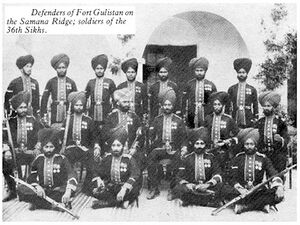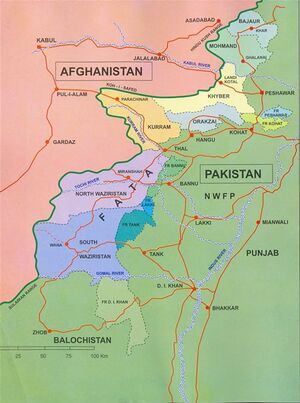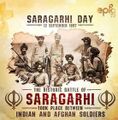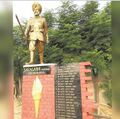Saragarhi


Saragarhi (सारागढ़ी) was a small village in the border district of Kohat, situated on the Samana Range, in present-day Pakistan. It is known for the Battle of Saragarhi.
Battle of Saragarhi
The Battle of Saragarhi was fought before the Tirah Campaign on 12 September 1897 between the British colonial army and the native Afghan tribesmen.[1] It occurred in the North-West Frontier Province (now Khyber Pakhtunkhwa, Pakistan). Jat Sikh soldiers fought on behalf of the British Indian Army against Pashtun Orakzai tribesmen.
The British Indian contingent comprised 21 Jat Sikh soldiers of the 36th Sikhs (now the 4th battalion of the Sikh Regiment), who were stationed at an army post and were attacked by 10000 to 12,000 Afghans. The Sikhs, led by Havildar Ishar Singh, chose to fight to the death, in what is considered by some military historians as one of history's greatest last stands.[2] The post was recaptured two days later by another British Indian contingent.
As per Business Standard, the 4th Sikh battalion of Indian army commemorates the battle every year on 12 September, as Saragarhi Day.[3]
Situation: Saragarhi was a small village in the border district of Kohat, situated on the Samana Range, in present-day Pakistan. On 20 April 1894, the 36th Sikhs of the British Indian Army was created, under the command of Colonel J. Cook.[4] It was entirely composed of Jat Sikhs.[5] In August 1897, five companies of the 36th Sikhs under Lieutenant Colonel John Haughton were sent to the northwest frontier of British India (modern-day Khyber Pakhtunkhwa) and were stationed at Samana Hills, Kurag, Sangar, Sahtop Dhar and Saragarhi.
The British had partially succeeded in getting control of this volatile area, but tribal Pashtuns continued to attack British personnel from time to time. Thus a series of forts, originally built by Ranjit Singh, the ruler of the Sikh Empire, were consolidated. Two of the forts were Fort Lockhart (on the Samana Range of the Hindu Kush mountains), and Fort Gulistan (Sulaiman Range), situated a few miles apart. Fort Lockhart is located at 33.5562N 70.9188E.[6] Due to the forts not being visible to each other, Saragarhi was created midway, as a heliographic communication post. The Saragarhi post, situated on a rocky ridge, consisted of a small block house with loop-holed ramparts and a signalling tower.
A general uprising by the Afghans began there in 1897, and between 27 August and 11 September many vigorous efforts by Pashtuns to capture the forts were thwarted by the 36th Sikhs. In 1897, insurgent and inimical activities had increased, and on 3 and 9 September Afridi tribesmen, allied with the Afghans, attacked Fort Gulistan. Both the attacks were repulsed, and a relief column from Fort Lockhart, on its return trip, reinforced the signalling detachment positioned at Saragarhi, increasing its strength to three non-commissioned officers (NCOs) and eighteen other ranks (ORs).
The battle: Details of the Battle of Saragarhi are considered fairly accurate, because Gurmukh Singh signalled events to Fort Lockhart by heliograph[7] as they occurred.[8]
Around 09:00, approximately 6,000–10,000 Afghans reach the signalling post at Saragarhi. Sepoy Gurmukh Singh signals to Colonel Haughton, situated in Fort Lockhart, that they are under attack. Haughton states he cannot send immediate help to Saragarhi. The soldiers in Saragarhi decide to fight to the last to prevent the enemy from reaching the forts. Sepoy Bhagwan Singh is the first soldier to be killed and Naik Lal Singh is seriously wounded. Naik Lal Singh and Sepoy Jiwa Singh reportedly carry the body of Bhagwan Singh back to the inner layer of the post.
The enemy breaks a portion of the wall of the picket. Haughton signals that he has estimated that there are between 10,000 and 14,000 Pashtuns attacking Saragarhi. The leaders of the Pashtun forces reportedly make promises to the soldiers to entice them to surrender. Reportedly two determined attempts are made to rush open the gate, but are unsuccessful. Later, the wall is breached. Thereafter, some of the fiercest hand-to-hand fighting occurs.
In an act of outstanding bravery, Havildar Ishar Singh orders his men to fall back into the inner layer, whilst he remains to fight. However, this is breached and all but one of the defending soldiers are killed, along with many of the Pashtuns.
Sepoy Gurmukh Singh, who communicated the battle to Haughton, was the last surviving Sikh defender. He is stated to have killed 20 Afghans, the Pashtuns having to set fire to the post to kill him. As he was dying, he was said to have yelled repeatedly the Sikh battle cry "Bole So Nihal, Sat Sri Akal!" ("One will be blessed eternally, who says that God is the ultimate truth!").
Having destroyed Saragarhi, the Afghans turned their attention to Fort Gulistan, but they had been delayed too long, and reinforcements arrived there in the night of 13–14 September, before the fort could be captured.[9] The Pashtuns later admitted that they had lost about 180 killed[10] and many more wounded during the engagement against the 21 Sikh soldiers, but some 600 bodies[11] are said to have been seen around the ruined post when the relief party arrived (however, the fort had been retaken, on 14 September, by the use of intensive artillery fire,[12] which may have caused many casualties). The total casualties in the entire campaign, including the Battle of Saragarhi, numbered around 4,800.
Commemorative tablet

The inscription of a commemorative tablet reads:
- The Government of India have caused this tablet to be erected to the memory of the twenty one non-commissioned officers and men of the 36 Sikh Regiment of the Bengal Infantry whose names are engraved below as a perpetual record of the heroism shown by these gallant soldiers who died at their posts in the defense of the fort of Saragarhi, on the 12 September 1897, fighting against overwhelming numbers, thus proving their loyalty and devotion to their sovereign The Queen Empress of India and gloriously maintaining the reputation of the Sikhs for unflinching courage on the field of battle.
Order of Merit
The 21 Sikh non-commissioned officers and soldiers who died in the Battle of Saragarhi were from the Majha region of Punjab and were posthumously awarded the Indian Order of Merit, at that time the highest gallantry award which an Indian soldier could receive. The corresponding gallantry award was the Victoria Cross. The award is equivalent to today's Param Vir Chakra awarded by the President of India.
The names of the 21 recipients of the gallantry award are:
- Havildar Ishar Singh (regimental number 165)
- Naik Lal Singh (332)
- Lance Naik Chanda Singh (546)
- Sepoy Sundar Singh (1321)
- Sepoy Ram Singh (287)
- Sepoy Uttar Singh (492)
- Sepoy Sahib Singh (182)
- Sepoy Hira Singh (359)
- Sepoy Daya Singh (687)
- Sepoy Jivan Singh (760)
- Sepoy Bhola Singh (791)
- Sepoy Narayan Singh (834)
- Sepoy Gurmukh Singh (814)
- Sepoy Jivan Singh (871)
- Sepoy Gurmukh Singh (1733)
- Sepoy Ram Singh (163)
- Sepoy Bhagwan Singh (1257)
- Sepoy Bhagwan Singh (1265)
- Sepoy Buta Singh (1556)
- Sepoy Jivan Singh (1651)
- Sepoy Nand Singh (1221)
Comparisons with Thermopylae
The battle has frequently been compared to the Battle of Thermopylae, where a small Greek force faced a large Persian army under Xerxes I in 480 BC.[13] In both cases, a small defending force faced overwhelming odds, fighting to the last man and inflicting an extremely disproportionate number of fatalities on the attacking force.
In popular culture: In September 2017, Saragarhi: The True Story, a documentary by UK-based journalist-filmmaker Jay Singh-Sohal, was screened at the National Memorial Arboretum in Staffordshire to mark the 120th anniversary of the epic frontier battle.[14]
A TV series, 21 Sarfarosh - Saragarhi 1897 aired on Discovery Jeet from 12 February 2018 to 11 May 2018 starring Mohit Raina, Mukul Dev, and Balraj Singh Khehra.
As of December 2017, there are three Bollywood films being produced regarding the battle:
Sons of Sardaar: The Battle of Saragarhi. In July 2016, Ajay Devgn, shared a poster of the film, a sequel to Son of Sardaar. In August 2017, Devgn stated: "We are working on the script but it won’t happen for another two years because of the scale of the project."
Battle of Saragarhi. In August 2016, Randeep Hooda shared the first look on his Twitter page. This film is to be directed by Rajkumar Santoshi, starring Randeep Hooda, Vikramjeet Virk, and Danny Denzongpa. Filming is set to take place between November 2017 and March 2018.
In October 2017, Karan Johar announced a film titled Kesari, based on the Battle of Saragarhi, to be directed by Anurag Singh, starring Akshay Kumar, due to be released at Holi 2019.
With regards to speculation about multiple films being made about the battle, Randeep Hooda stated: "It is good because there were 21 Sikh heroes in that battle and each one of them deserved to have a movie made on them. So actually there should be 21 films made on them."
Jat History
Ram Sarup Joon[15] writes that ...In 1897, Sikh was stationed at Kohat. One of the platoons under Havildar Ishwar Singh was holding the post of Saragarhi. Early in the morning about 1000 Pathans surrounded the post and tried to get in. First a flag message was received at the Company Headquarters at Thal. 'We are firing heavily at the enemy.' The second message was 'Ammunition is finished, Pathans are scaling the walls. We are trying to keep them away with Bayonets.' The third message came: 'I won't be able to send any more messages, I am joining to the Bayonet fighters.' All the Sikh Jawans died fighting. 600 dead bodies of the enemy were found around the Post. Every one of the 21 soldiers was awarded an IOM (Indian Order of Merit).
सारागढ़ी का युद्ध
अक्षय कुमार की केसरी फ़िल्म रिलीज हुई है जो दुनिया के सबसे अद्भुत युद्ध पर आधारित है जिसमें एक तरफ 21 जाट थे तो दूसरी तरफ 10000 अफगान। आपने “ग्रीक सपार्टा” और “परसियन” की लड़ाई के बारे में सुना होगा ……इनके ऊपर “300” जैसी फिल्म भी बनी है।
पर अगर आप “सारागढ़ी” के बारे में पढोगे तो पता चलेगा इससे महान लड़ाई भारतभूमि मे हुई थी …. बात 1897 की है …..नॉर्थ वेस्ट फ्रंटियर स्टेट में 10 हजार अफगानों ने हमला कर दिया ……वे गुलिस्तान और लोखार्ट के किलों पर कब्जा करना चाहते थे।
इन किलों को महाराजा रणजीत सिंह ने बनवाया था ….. इन किलों के पास सारागढी में एक सुरक्षा चौकी थी …..जहां पर 36 वी सिख रेजिमेट के 21 जाट जवान तैनात थे …ये सभी जवान माझा क्षेत्र के थे और सभी जाट क्षत्रिय परिवार से थे। 36 वीं सिख रेजिमेंट में केवल साबत सूरत (जो केशधारी हों) सिख भर्ती किये जाते थे।
हवलदार ईशरसिंह गिल के नेतृत्व में तैनात इन 21 जवानों को पहले ही पता चल गया कि 10 हजार अफगानों से जिंदा बचना नामुमकिन है। फिर भी इन जवानों ने लड़ने का फैसला लिया और 12 सितम्बर 1897 को भारतभूमि की धरती पर एक ऐसी लड़ाई हुयी जो दुनिया की पांच महानतम लड़ाइयों में शामिल हो गयी। एक तरफ 10 हजार अफगान थे …..तो दूसरी तरफ 21 भारतीय जाट वीर।
अफगान के अब्दाली की क्रूरता के बारे में आपको पता ही होगा। उस समय अफगानों से देश को बचाना सबसे जरूरी था।खासकर पंजाब पर इनका खतरा मंडराता रहता था। अंग्रेजों से कहीं ज्यादा इन अफगानों की क्रूरता और दुष्टता का खतरा रहता था।
यहा बड़ी भीषण लड़ाई हुयी और इसमें लगभग 600 से 800 अफगान मारे गये और अफगानों की भारी तबाही हुयी ….. सब जवान आखिरी सांस तक लड़े और इन किलों को बचा लिया। अफगानों की हार हुयी ….. जब ये खबर यूरोप पंहुची तो पूरी दुनिया स्तब्ध रह गयी ……ब्रिटेन की संसद में सभी ने खड़ा होकर इन 21 वीरों की बहादुरी को सलाम किया ….. इन सभी को मरणोपरांत इंडियन ऑर्डर ऑफ मेरिट दिया गया। जो आज के परमवीर चक्र के बराबर था। भारत के सैन्य इतिहास का ये युद्ध के दौरान सैनिकों द्वारा लिया गया सबसे विचित्र अंतिम फैसला था।
UNESCO ने इस लड़ाई को अपनी 8 महानतम लड़ाइयों में शामिल किया। इस लड़ाई के आगे स्पार्टन्स की बहादुरी फीकी पड़ गयी …… पर दुख होता है कि जो बात हर भारतीय को पता होनी चाहिए …… उसके बारे में कम लोग ही जानते है …….ये लड़ाई यूरोप के स्कूलों में पढाई जाती है पर हमारे यहां जानते तक नहीं।
इन 21 वीरों के नाम इस प्रकार हैं
- हवलदार ईशर सिंह गिल (रेजिमेंटल नम्बर 165)
- नायक लाल सिंह (332)
- नायक चंदा सिंह (546)
- लांस नायक सुंदर सिंह (1321)
- लांस नायक राम सिंह (287)
- लांस नायक उत्तर सिंह (492)
- लांस नायक साहिब सिंह (182)
- सिपाही हीरा सिंह (359)
- सिपाही दया सिंह (687)
- सिपाही जीवन सिंह (760)
- सिपाही भोला सिंह (791)
- सिपाही नारायण सिंह (834)
- सिपाही गुरमुख सिंह (814)
- सिपाही जीवन सिंह (871)
- सिपाही गुरमुख सिंह (1733)
- सिपाही राम सिंह (163)
- सिपाही भगवान सिंह (1257)
- सिपाही भगवान सिंह (1265)
- सिपाही बूटा सिंह (1556)
- सिपाही जीवन सिंह (1651)
- सिपाही नन्द सिंह (1221)
हमारी वीरता पर केसरी फ़िल्म रिलीज हो गई है जो हर भारतीय के लिए गर्व की बात है
Gallery
Further reading
- Saragarhi and the Defence of the Samana Forts by Amarinder Singh, New Delhi : Bookwise (India) Pvt. Ltd., 2017 ISBN 978-8187330677
- Saragarhi: The Forgotten Battle by Jay Singh-Sohal, Birmingham: Dot Hyphen Publishers, 2013 (ISBN 978-0957054073)
- Saragarhi Battalion: Ashes to Glory by Kanwaljit Singh and H.S. Ahluwalia, New Delhi : Lancer International, 1987 (ISBN 81-7062-022-8)
- Against All Odds At Saragarhi by Anuj Harshwardhan Sharma, 2017 (ASIN BO77C94TXJ)
References
- ↑ Stewart, Jules (15 August 2011). On Afghanistan's Plains: The Story of Britain's Afghan Wars. I.B. Tauris.
- ↑ Pandey, Geeta (5 December 2011). "India polo match honours Sikhs' 1897 Saragarhi battle". British Broadcasting Corporation. bbc.co.uk.
- ↑ Singh, Jaisal (13 September 2014). "The 21 Sikhs of Saragarhi" – via Business Standard.
- ↑ Pall, S.J.S. "The story of Valiant Sikhs", Amritsar, B. Chattar Singh (2004) p. 98
- ↑ Sharma, Gautam (1990). Valour and Sacrifice: Famous Regiments of the Indian Army. Allied Publishers. p. 185. ISBN 978-8170231400.
- ↑ "Fort Lockhart Geo Location"
- ↑ "Defense of Saragarhi PosT". Camperdown Chronicle (Vic. : 1877–1954). National Library of Australia. 5 December 1907.
- ↑ Pall, S.J.S. "The story of Valiant Sikhs", Amritsar, B. Chattar Singh (2004) p. 98
- ↑ "No. 26937". The London Gazette. 11 February 1898. p. 863.
- ↑ Major General Jaswant Singh Letter to H.M. Queen Elizabeth II Archived 12 October 2007 at the Wayback Machine Institute of Sikh Studies (1999)
- ↑ Sharma, Gautam (1990). Valour and Sacrifice: Famous Regiments of the Indian Army. Allied Publishers. p. 185. ISBN 978-8170231400.
- ↑ "The Frontier War," Daily News, London (16 Sep 1897)
- ↑ Singh, Kanwaljit & Ahluwalia, H.S. Saragarhi Battalion: Ashes to Glory, India, Lancer International (1987) ISBN 81-7062-022-8
- ↑ Saragarhi saga captured on film
- ↑ Ram Sarup Joon:History of the Jats/Chapter XIII,p.227



